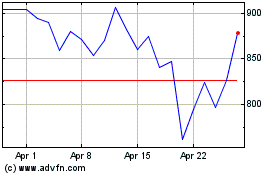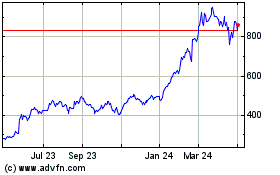The $40 billion game-changer could be a potent tool for Jensen
Huang to battle Intel
By Asa Fitch
This article is being republished as part of our daily
reproduction of WSJ.com articles that also appeared in the U.S.
print edition of The Wall Street Journal (September 16, 2020).
In the midst of the pandemic, Nvidia Corp. Chief Executive
Jensen Huang engineered his company's biggest game changer from his
kitchen: a $40 billion acquisition that could cement his status as
the semiconductor industry's hottest CEO.
The proposed acquisition of Arm Holdings from SoftBank Group
Corp., in the chip industry's biggest deal ever, would transform
Nvidia into a force across the most important arenas of computing,
from servers and PCs to consumer electronics to smartphones, making
it one of the most formidable threats Intel Corp. has ever faced.
To do so, though, Mr. Huang still needs to clear regulatory hurdles
and potential opposition from competitors that may appeal to
authorities to block the deal.
The deal is a milestone in an extraordinary run over the past
few years, one that has transformed Nvidia from a niche maker of
high-end graphics chips for gamers into the most valuable U.S. chip
company. "I couldn't have dreamed two years ago that I'd be sitting
here," Mr. Huang told The Wall Street Journal this week.
Nvidia's market value has soared to $319.8 billion, surpassing
Intel's valuation of $214.5 billion, even though Nvidia had $10.92
billion in annual sales in its latest fiscal year, compared with
$71.97 billion for Intel. Nvidia's bet on some of the hottest
fields in tech, videogaming and artificial intelligence, have
fueled investor enthusiasm, while Intel has stumbled with some of
its most advanced chips.
It is a long way from 1993, when Mr. Huang dreamed up Nvidia on
his 30th birthday at a Denny's in San Jose, Calif., with two
like-minded engineers. They bet on a future where consumers
demanded better computer graphics, which would require specialized,
high-performance hardware that wasn't available at the time.
That bet has paid off. Videogaming has taken off, and its
processors have found new applications. To deliver the best video
content, Nvidia's graphics chips handle data differently than
traditional designs, processing information in parallel rather than
sequentially. That approach has also proven particularly useful to
cryptocurrency mining and running AI software that is in
increasingly hot demand.
Mr. Huang, now 57 years old, early on styled himself after Steve
Jobs, adopting a black leather jacket as his edgier version of the
late Apple Inc. co-founder's black turtleneck. Also like Mr. Jobs,
the Nvidia boss hogs the stage during his company's unveilings of
ever-faster graphics chips.
The Arm deal couldn't have happened if it weren't for Mr.
Huang's ties to SoftBank's CEO, Masayoshi Son, who bought
Cambridge, England-based Arm in 2016 for $32 billion. SoftBank has
invested in Nvidia and, at the end of June, held a stake valued at
around $245 million at Monday's close.
SoftBank first approached Nvidia earlier this year to gauge Mr.
Huang's interest in making a deal. "At some point it became clear
that SoftBank would be interested in maybe not holding onto Arm,
and I just jumped on the opportunity," Mr. Huang said, adding his
focus then turned to ensuring Nvidia was the top bidder.
Mr. Huang limited his use of outside bankers and largely
negotiated the deal with an internal team. Amid the pandemic, he
worked out the terms not from the company's Santa Clara, Calif.,
headquarters, but from his nearby home in the hills outside Palo
Alto, where he also hosted virtual conferences and product launches
from his kitchen, occasionally shedding his signature leather
jacket for a down vest.
To James Wang, a former Nvidia product manager who is now an
analyst at New York-based asset manager Ark Invest, which is an
investor in Nvidia through some of its funds, the Arm deal is a
sign that Mr. Huang realized that the next step of Nvidia's growth
couldn't happen without outside help. "That's the attitude change
that's enabled Nvidia to go from a big M&A-averse company to
one that's just swinging for the fences, " he said.
Arm, known for its power-efficient chip design, could become a
potent tool for Mr. Huang to battle Intel across a broader range of
products. Apple said in June that it was ditching Intel in its Mac
computers in favor of its own chip design with Arm ingredients.
Mr. Huang says Nvidia could offer Arm an entry into hardware for
AI computations in devices like phones, watches, gadgets and cars
-- areas where it previously had a more limited presence. At the
same time, Nvidia could help introduce Arm-based devices into
central processors for the kind of servers that go into big data
centers and supercomputers and challenge Intel's dominance
there.
Eric Ross, chief strategist at Cascend Securities in New York,
said Mr. Huang told him about two decades ago that he was gunning
for Intel, betting that his graphics processors would become the
calculation workhorses of the next age of computing. "It did take
awhile, but he's had his eye on this for a very long time," Mr.
Ross said.
Nvidia has faced recent setbacks. Its growth slumped after the
boom in cryptocurrencies flamed out. An earlier foray into
smartphone modems via an acquisition in 2011 fizzled, and the
company wound down the business in 2015.
And the sale of some of its chips and their use in China for
artificial intelligence has raised concerns in Washington.
The Arm deal also could run into political turbulence amid the
U.S. battle with China over dominance in the tech sector. Huawei
Technologies Co., which has been at the center of U.S. efforts to
curb China's technology ambitions, is a big Arm customer and would
owe Nvidia licensing fees to use its technology.
Nvidia's biggest acquisition to date, a $7 billion deal for
Mellanox Technologies Ltd., faced delays because of protracted
regulatory scrutiny in China. It closed in April.
British politicians have already expressed reservations over
potential job losses at Arm's home base. Arm has around 6,700
employees. Nvidia and Arm have promised to establish a new AI
research center with a new supercomputer in Cambridge that would be
open to researchers in the U.K. and elsewhere.
Chip-industry opposition will also likely be strong, analysts
say. Some of Arm's customers also compete with Nvidia, raising
questions about Arm's neutrality should the deal go through. Arm
has long acted as a kind of Switzerland to the chip industry,
offering its designs to everyone without favoring any one company.
Nvidia and Arm are promising that won't change.
Mr. Huang, who anticipated a future where demand would surge for
content built around high-quality graphics, is planning for the
next phase of computing powered by his chips. "Homes will have
holodecks," he said at a recent virtual conference. "We will beam
ourselves through time and space, traveling at the speed of light,
sending photons, not atoms."
-- For more WSJ Technology analysis, reviews, advice and
headlines, sign up for our weekly newsletter.
Write to Asa Fitch at asa.fitch@wsj.com
(END) Dow Jones Newswires
September 16, 2020 02:47 ET (06:47 GMT)
Copyright (c) 2020 Dow Jones & Company, Inc.
NVIDIA (NASDAQ:NVDA)
Historical Stock Chart
From Mar 2024 to Apr 2024

NVIDIA (NASDAQ:NVDA)
Historical Stock Chart
From Apr 2023 to Apr 2024
